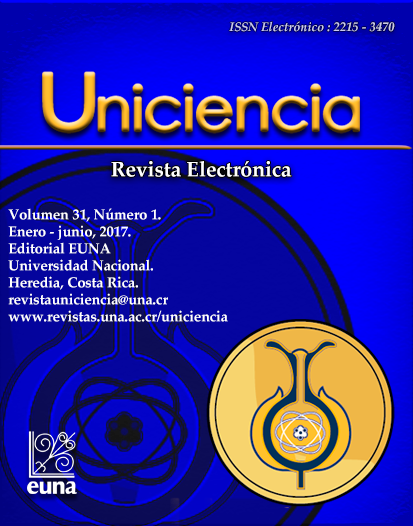Activities That May Influence the Risk of Crocodile (Crocodylus Acutus: Reptilia: Crocodilidae) Attack to Humans in the Tempisque River Area, Guanacaste, Costa Rica.
DOI:
https://doi.org/10.15359/ru.31-1.2Keywords:
Crocodile, risk of attack, population density, Costa Rica, Tempisque River.Abstract
One of the largest populations of crocodiles in Costa Rica is located at the Tempisque River. The species is threatened by habitat loss and poaching; but its populations have grown due to the protection given by law. The research was conducted in Guanacaste, Costa Rica. We made a characterization of popular knowledge, activities and perceptions of 374 residents of the study area. It was found that 55% believe that the crocodiles are abundant, 70% believe that populations have increased. The most dangerous activities done are recreation, swimming and fishing. There are significant differences between the proportions of response (X2: 71, n = 10, p <0.0001 X2). These activities are done daily (25%), weekly (30%), monthly (18%) and annually (10%). The risk of attack and the crocodile’s density in the river are not recognized. Also, a lack of knowledge about the natural history and ecology of the species is shown. The reasons for attacks are: the aggressiveness of the animals and their density. There are differences in the responses on the reasons of the attacks (X2: 35, n 8 p <0.0001). Generally, the crocodile perception is unfavorable.
References
Balaguera-reina, S. A., & González-maya, J. F. (2010). Percepciones, conocimiento y relaciones entre los Crocodylia y poblaciones humanas en la Vía Parque Isla de Salamanca y su zona de amortiguamiento, Caribe colombiano. Latin American Journal of Conservation, 1(1), 53–63.
Bolaños J. (2012a). Manejo de cocodrilos (Crocodylus acutus) en estanques de cultivo de tilapia en Cañas, Guanacaste”, Ambientales 43, 63-72. http://dx.doi.org/10.15359/rca.43-1.6
Bolaños, J. (2011a). Plan Estratégico para el Manejo de la población de Crocodylus acutus (cocodrilo americano), en el Gran Humedal Tempisque. Sistema Nacional de Áreas de Conservación. Dirección Regional. Área de Conservación Arenal Tempisque. Documento técnico. 20 p.
Bolaños, J. (2011b). Propuesta plan de contingencia en el manejo de la población de cocodrilos del gran humedal del Tempisque. Asociación Especialistas en Crocodílidos – Centro América. Documento técnico.
Bolaños, J. (2012b). Survey of American Crocodiles in Tempisque Great Wetlands, Guanacaste, Costa Rica. Crocodile Specialist Group Newsletter. 31 (1): 2-7
Bolaños, J. R., J. Sánchez & L. Piedra. (1997). Inventario y estructura poblacional de crocodílidos en tres zonas de Costa Rica. Rev. Biol. Trop. 45(1), 283-287.
Child, G. (1987). The Management of Crocodiles in Zimbabwe. Pp. 49-62. In: G. J. W. Webb, S. C. Manolis, and P. J. Whitehead (editors). Wildlife Management: Crocodiles and Alligators. Surrey Beatty & Sons Pty Limited, Chipping Norton, Australia. 552 pp.
Fonseca, A. (2008). Decimocuarto Informe del Estado de la Nación en Desarrollo Humano Sostenible. Capítulo 4: Armonía con la naturaleza. La zona marino costera. San José, Costa Rica.
Hernández, J. (2007). Convivir con nuestros cocodrilos. Revista mensual sobre la actividad ambiental, Ambientico. Nº 166 11-13pp.
Joanen, T. and L. McNease. (1980). Reproductive Biology of the American Alligator in Southwest Louisiana. Proceedings of the Society for the Study of Amphibians and Reptiles Symposium: Reproductive Biology and Diseases of Captive Reptiles 1:153-159.
Menacho, R. M. (2001). Turismo y vida silvestre en humedales del Tempisque. Ciencias Ambientales. 21: 13-22.
Morales, A. (2013). Percepciones y conocimiento popular sobre cocodrilos (Crocodylusacutus) en las zonas aledañas al río Tempisque, Costa Rica. Biocenosis, 27 (1-2), 71–76.
Orozco, W. (2015). Monitoreo de la población de cocodrilos (Crocodylus acutus) en el río Tempisque. Guanacaste. Costa Rica. 2011-2014. Informe final de Práctica Dirigida para optar por el título de Bachiller en Manejo de Recursos Naturales. Universidad Estatal a Distancia (UNED). San José. Costa Rica. 43p.
Pooley, A.C., Hines, T. and Shields, J. (1989). Attacks on Humans. Pp. 172-186 in Crocodiles and Alligators. Weldon Owen: New York. pp 172-187
Sánchez-Ramírez, J. (2001). Estado de la población de cocodrilos (Crocodylus acutus) en el río Tempisque, Guanacaste, Costa Rica. INBio, Heredia, Costa Rica.
Thorbjarnarson, J. B. (1989). Ecology of American Crocodile, Crocodylus acutus. pp 228-259. In: International Union for the Conservation of Nature (Ed.). Crocodiles: Their Ecology, Management and Conservation. UICN, Gland, Suiza.
Valdelomar, V., Ramírez-Vargas, M. A., Quesada-Acuña, S. G., Arrieta, C., Carranza, I., Ruiz-morales, G., Espinoza-bolaños, S., et al. (2012). Percepción y conocimiento popular sobre el cocodrilo Crocodylus acutus (Reptilia: Crocodylidae) en zonas aledañas al río Tempisque, Guanacaste, Costa Rica. Cuaderno de Investigación UNED, 4(2), 191–202.
Published
How to Cite
Issue
Section
License
Authors who publish with this journal agree to the following terms:
1. Authors guarantee the journal the right to be the first publication of the work as licensed under a Creative Commons Attribution License that allows others to share the work with an acknowledgment of the work's authorship and initial publication in this journal.
2. Authors can set separate additional agreements for non-exclusive distribution of the version of the work published in the journal (eg, place it in an institutional repository or publish it in a book), with an acknowledgment of its initial publication in this journal.
3. The authors have declared to hold all permissions to use the resources they provided in the paper (images, tables, among others) and assume full responsibility for damages to third parties.
4. The opinions expressed in the paper are the exclusive responsibility of the authors and do not necessarily represent the opinion of the editors or the Universidad Nacional.
Uniciencia Journal and all its productions are under Creative Commons Atribución-NoComercial-SinDerivadas 4.0 Unported.
There is neither fee for access nor Article Processing Charge (APC)






